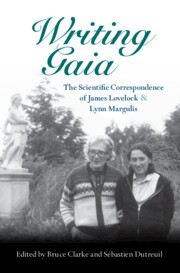Refine search
Actions for selected content:
13588 results in History of science and technology
2004
- from Part IV - 1992–2007
-
- Book:
- Writing Gaia: The Scientific Correspondence of James Lovelock and Lynn Margulis
- Published online:
- 28 July 2022
- Print publication:
- 18 August 2022, pp 376-381
-
- Chapter
- Export citation
1985
- from Part III - 1980–1991
-
- Book:
- Writing Gaia: The Scientific Correspondence of James Lovelock and Lynn Margulis
- Published online:
- 28 July 2022
- Print publication:
- 18 August 2022, pp 250-257
-
- Chapter
- Export citation
1978
- from Part II - 1973–1979
-
- Book:
- Writing Gaia: The Scientific Correspondence of James Lovelock and Lynn Margulis
- Published online:
- 28 July 2022
- Print publication:
- 18 August 2022, pp 179-183
-
- Chapter
- Export citation
1997
- from Part IV - 1992–2007
-
- Book:
- Writing Gaia: The Scientific Correspondence of James Lovelock and Lynn Margulis
- Published online:
- 28 July 2022
- Print publication:
- 18 August 2022, pp 355-355
-
- Chapter
- Export citation
Befriending Gaia: My Early Correspondence with Jim Lovelock
- from Part V - Commentaries on Lovelock and Margulis
-
-
- Book:
- Writing Gaia: The Scientific Correspondence of James Lovelock and Lynn Margulis
- Published online:
- 28 July 2022
- Print publication:
- 18 August 2022, pp 408-416
-
- Chapter
- Export citation
Darwinizing Gaia
- from Part V - Commentaries on Lovelock and Margulis
-
-
- Book:
- Writing Gaia: The Scientific Correspondence of James Lovelock and Lynn Margulis
- Published online:
- 28 July 2022
- Print publication:
- 18 August 2022, pp 391-393
-
- Chapter
- Export citation
1977
- from Part II - 1973–1979
-
- Book:
- Writing Gaia: The Scientific Correspondence of James Lovelock and Lynn Margulis
- Published online:
- 28 July 2022
- Print publication:
- 18 August 2022, pp 167-178
-
- Chapter
- Export citation
Reviews
-
- Book:
- Writing Gaia: The Scientific Correspondence of James Lovelock and Lynn Margulis
- Published online:
- 28 July 2022
- Print publication:
- 18 August 2022, pp ii-iv
-
- Chapter
- Export citation
Discovering Geology, Discovering Gaia
- from Part V - Commentaries on Lovelock and Margulis
-
-
- Book:
- Writing Gaia: The Scientific Correspondence of James Lovelock and Lynn Margulis
- Published online:
- 28 July 2022
- Print publication:
- 18 August 2022, pp 431-434
-
- Chapter
- Export citation

A Concise History of Veterinary Medicine
-
- Published online:
- 11 August 2022
- Print publication:
- 25 August 2022
Visual duplication: specimens, works of art and photographs at the Musée d'ethnographie du Trocadéro (1928–1935)
-
- Journal:
- The British Journal for the History of Science / Volume 55 / Issue 3 / September 2022
- Published online by Cambridge University Press:
- 08 August 2022, pp. 365-388
- Print publication:
- September 2022
-
- Article
- Export citation
Globalizing ‘science and religion’: examples from the late Ottoman Empire
-
- Journal:
- The British Journal for the History of Science / Volume 55 / Issue 4 / December 2022
- Published online by Cambridge University Press:
- 02 August 2022, pp. 445-458
- Print publication:
- December 2022
-
- Article
- Export citation

Writing Gaia: The Scientific Correspondence of James Lovelock and Lynn Margulis
-
- Published online:
- 28 July 2022
- Print publication:
- 18 August 2022
Book 5 - Africa and Western Asia
-
- Book:
- A Guide to the Geography of Pliny the Elder
- Published online:
- 07 July 2022
- Print publication:
- 28 July 2022, pp 247-320
-
- Chapter
- Export citation
Maps
-
- Book:
- A Guide to the Geography of Pliny the Elder
- Published online:
- 07 July 2022
- Print publication:
- 28 July 2022, pp viii-viii
-
- Chapter
- Export citation
Bibliography
-
- Book:
- A Guide to the Geography of Pliny the Elder
- Published online:
- 07 July 2022
- Print publication:
- 28 July 2022, pp 409-423
-
- Chapter
- Export citation
Book 3 - Southern Europe
-
- Book:
- A Guide to the Geography of Pliny the Elder
- Published online:
- 07 July 2022
- Print publication:
- 28 July 2022, pp 104-185
-
- Chapter
- Export citation
Index of Passages Cited
-
- Book:
- A Guide to the Geography of Pliny the Elder
- Published online:
- 07 July 2022
- Print publication:
- 28 July 2022, pp 424-452
-
- Chapter
- Export citation
Book 6 - The Remainder of Asia
-
- Book:
- A Guide to the Geography of Pliny the Elder
- Published online:
- 07 July 2022
- Print publication:
- 28 July 2022, pp 321-408
-
- Chapter
- Export citation
Introduction
-
- Book:
- A Guide to the Geography of Pliny the Elder
- Published online:
- 07 July 2022
- Print publication:
- 28 July 2022, pp 1-14
-
- Chapter
- Export citation
